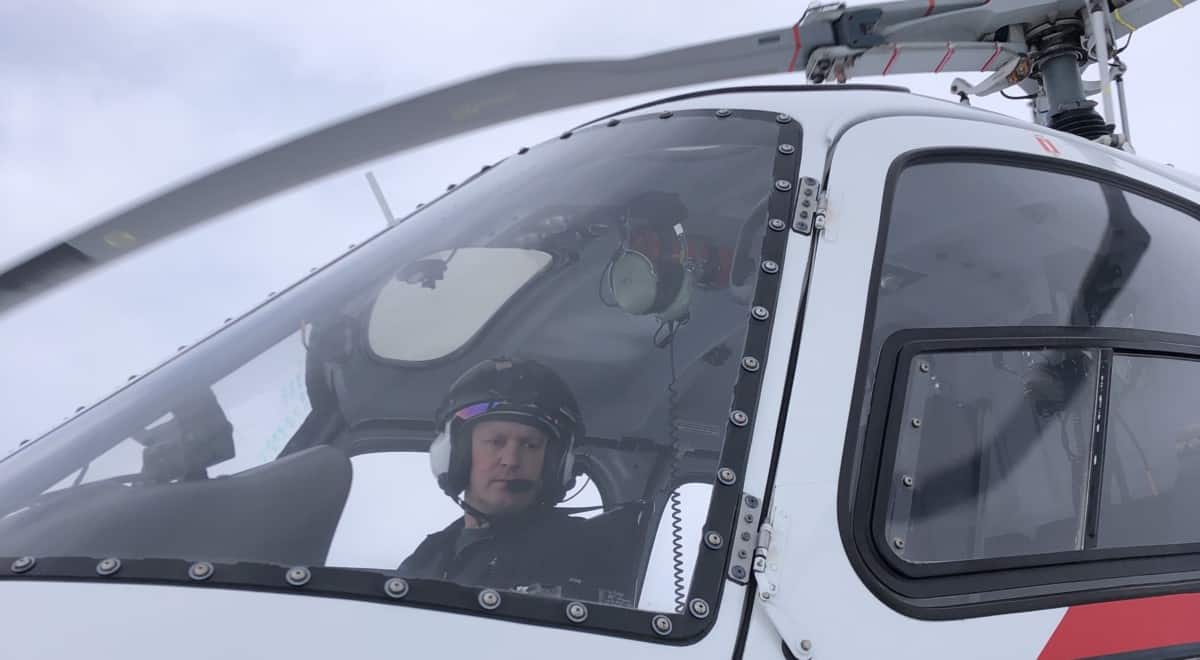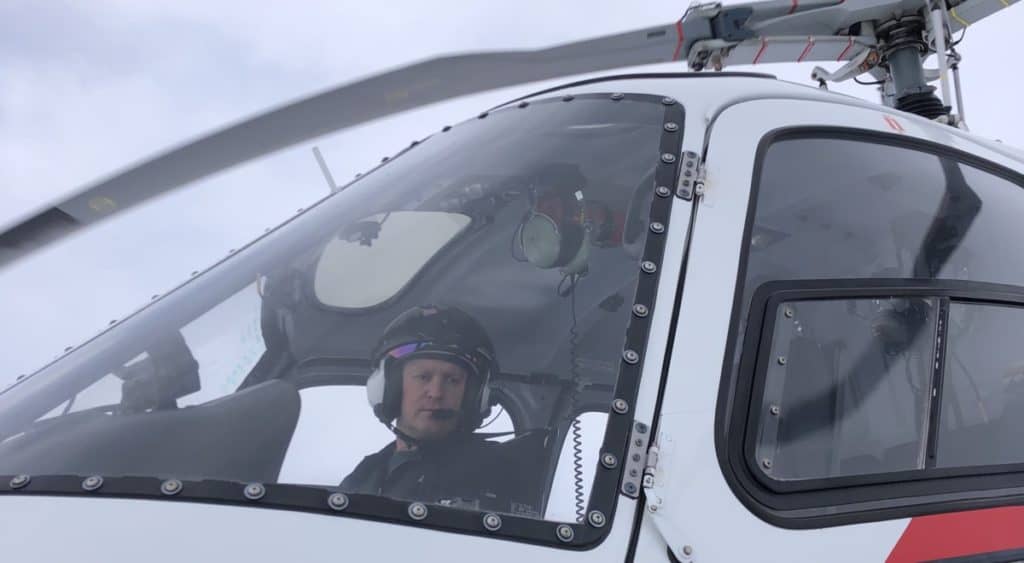
It seems to be common knowledge that airplanes are flown from the left seat, but what about helicopters? There are helicopters with pilots sitting in the right seat, some in the left seat and some have pilots in both seats. So which seat is primarily used for flying a helicopter?
Most helicopter pilots are right-handed & find controlling the helicopter easier as the first helicopter designs made the cyclic the stiffest and hardest control to manipulate. The first generation of pilots set this tradition, thus allowing the left hand free to operate buttons, switches & radios.
The first helicopters were flown right seat when only one pilot was in the cockpit, but today there are various helicopters that can be flown left or right, and some that are limited to only left or right. Let’s take a look at how and why I sit right seat every time I fly…
Early Helicopter Pilot Seating Arrangements
The very first mass-produced helicopter was the R-4 by Igor Sikorsky at Sikorsky Helicopters. The helicopter design was so underpowered that it had to be kept as light as possible. This meant that the helicopter was designed with only one Collective mounted between both pilot seats, but a cyclic for each pilot. The cyclic’s were mounted between the knees of each pilot.
- The Cyclic controls the helicopter’s position over the ground in a hover and its pitch and roll attitudes when in forward flight. Today it is held with the right hand
- The Collective controls the helicopter’s power and height above the ground. Raising the collective causes the helicopter to climb, lowering causes it to descend. Today is it held with the left hand
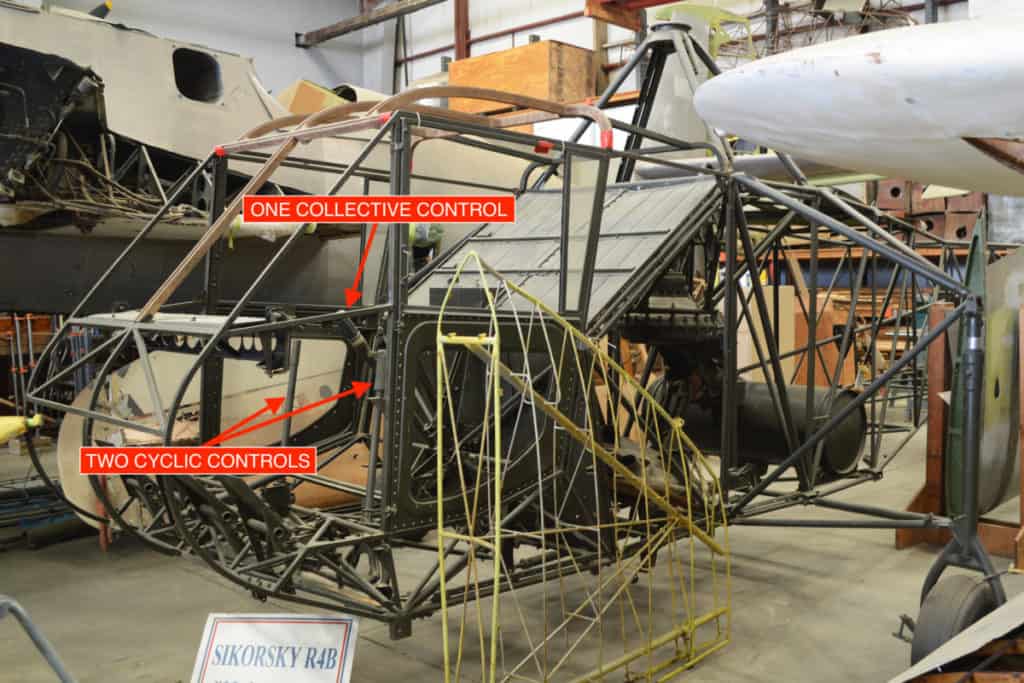
The design allowed the instructor and the student to fly at the same time, but the cyclic control was so stiff to manipulate, but also the most sensitive and critical. At that time the majority of the students were right-handed, thus elected to sit in the right seat and control the cyclic with their right hand. If they sat in the left seat, they had to control the cyclic with their left hand and operate the shared collective with their right hand instead.
This led to the first generation of helicopter pilots of the U.S. Army Airforces, Coast Guard, Navy, and also the British Fleet Air Arm and Royal Air Force all learning to fly from the right seat. This set the tradition of a helicopter to be flown from the right seat, however, it could be flown from either seat depending on which hand the pilot preferred to control the cyclic with.
After the second mass-produced helicopter, the Sikorsky R-6, helicopters were manufactured with both a collective and a cyclic at each pilot seat. This is now how all helicopters are built, however, most helicopters are able to have the left-hand pilot flight controls removed so passengers can sit in the front left seat and not interfere with the flight controls.

Join My Newsletter & Get Great Tips, Information and Experiences To Help You Become a Superb Pilot!
Operational Limitations
The second major reason why the right-hand flying position has remained is due to the instability in a helicopter as it flies. An airplane is known as ‘Dynamically Stable’ and this means that if the pilot were to take their hands and feet off the controls, providing it was trimmed out, the airplane would fly straight and level, due to its aerodynamic stability.
Helicopters, on the other hand, are ‘Dynamically Unstable’, meaning that if the pilot were to take their hand off the cyclic, the aerodynamic instability of the helicopter would cause it to pitch and roll by itself. If left to continue the helicopter would end up in an unrecoverable attitude that would overcome the strength of the fuselage and/or rotor system leading to a catastrophic component failure, or if low enough, an impact with the ground.
Because of this dynamic instability, the helicopter pilot must keep their hand on the cyclic at all times – Newer helicopters have hydraulic trim systems and autopilots to allow for hands-free flying, however, the early helicopters and today’s smaller, light helicopters need the hand to remain on the cyclic at all times.
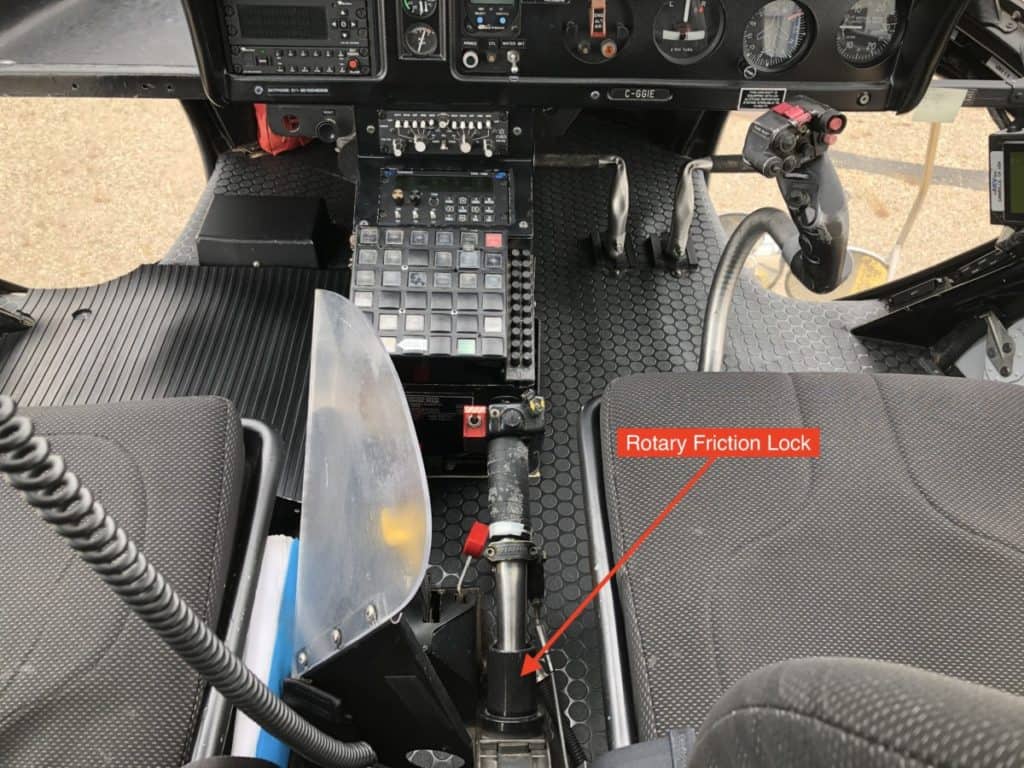
Just as with the early helicopter graduates, most people are still right-handed thus controlling the cyclic is done with their right hand, while allowing the left hand to leave the collective to manipulate switches, buttons, radios, navigation systems, write and hold charts. The collective is far less sensitive and when in cruise flight it can have a ‘Friction’ applied to hold it in position.
Helicopter Center of Gravity Limitations
In smaller, lightweight helicopters the positioning of a person within the aircraft can have a drastic effect on the balance of the helicopter when it leaves the ground.
For example, the Robinson R22 helicopter has a passage in the Limitations section of its flight manual that states that when flying the helicopter by yourself the pilot MUST sit in the right seat only.
Because this is in the Limitations section it must be complied with to ensure the safety of flight.
The main reason for this is to ensure the helicopter has enough control movement within its cyclic range to ensure the aircraft can be kept upright and be able to roll out from a turn.
Due to aerodynamic forces acting on the helicopter (For another article) all helicopters will sit in a hover with one skid lower than the other (Left skid low for North-American-made helicopters, right skid low for European-made helicopters).
The R22 for example sits left skid low, if a 200lb pilot then sits in the left seat this puts the center of gravity of the helicopter way out to the left of the main rotor mast.
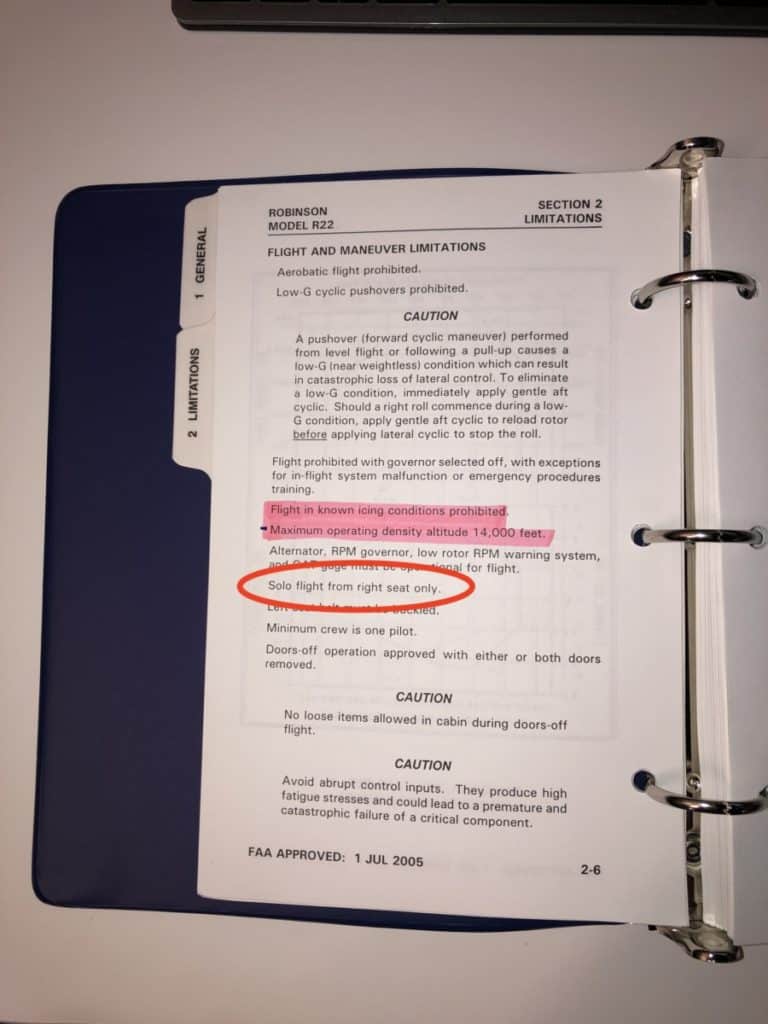
If the pilot then puts the helicopter in a left banking turn the center of gravity moves even further left. It can reach a point where there is not enough control movement to turn the helicopter back to the right and thus the helicopter will not be able to be placed back into level flight and an unstoppable left-hand turn will end up with the helicopter impacting the ground at some point.
By limiting the pilot to sitting in the right seat, this keeps the helicopter’s center of gravity within limitations to allow the helicopter to remain under full control no matter what movement the pilot puts in.
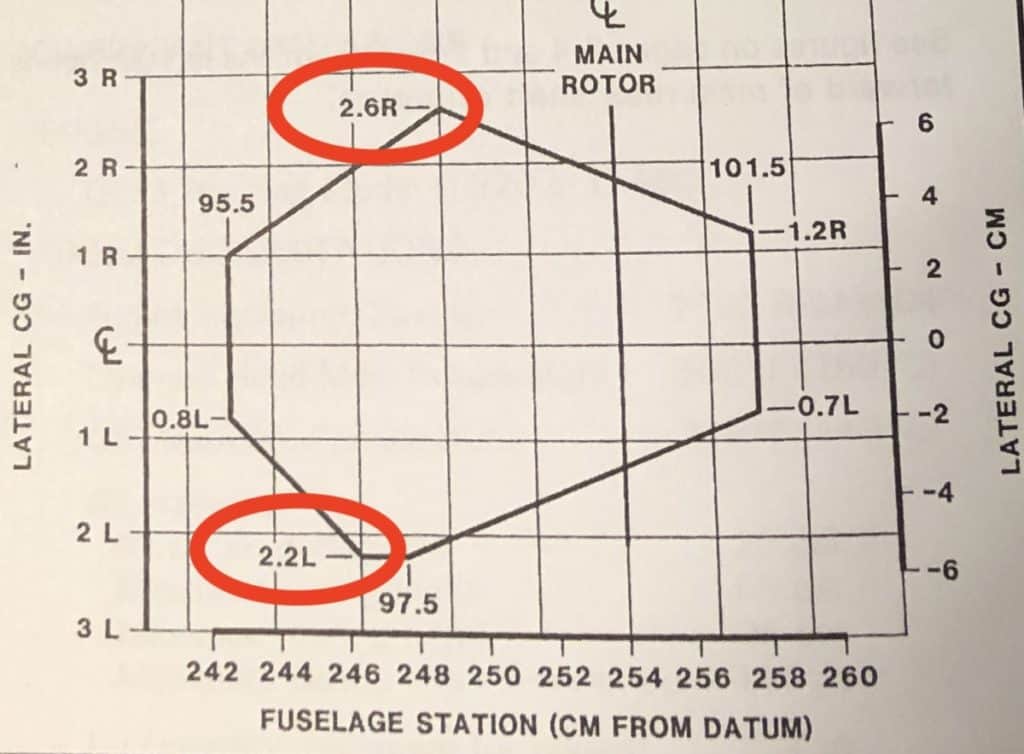
Here you can see that the helicopter’s lateral center of gravity goes out of limit at 2.2″ inches on the left, but 2.6″ on the right. This is because of the ‘Left Skid Low’ attitude that the helicopter sits in. Larger helicopters have a much wider center of gravity envelope making the seating position of the pilot far less critical.
Operational Benefits
When the helicopter’s center of gravity allows, there are some operational benefits that allow the pilot to sit in the left seat makes sense. Some of the more common reasons why a helicopter is designed for the flying pilot to sit in the left seat are:
Tours
When the collective is mounted in between the front seats it can pose a risk to unknowing passengers. An accidental drop of a camera or a passenger using their hands to press down on something ( ie. the nice handle that is the collective) to readjust their seating position has happened with terrifying effects! Both happened to me!
By moving the pilot to the far left seat, the collective and all the other flight controls are moved well away from the passengers, this can also free up room for an additional seat to be installed in the front, thus increasing the carrying capacity of the helicopter – Great for a tour business.
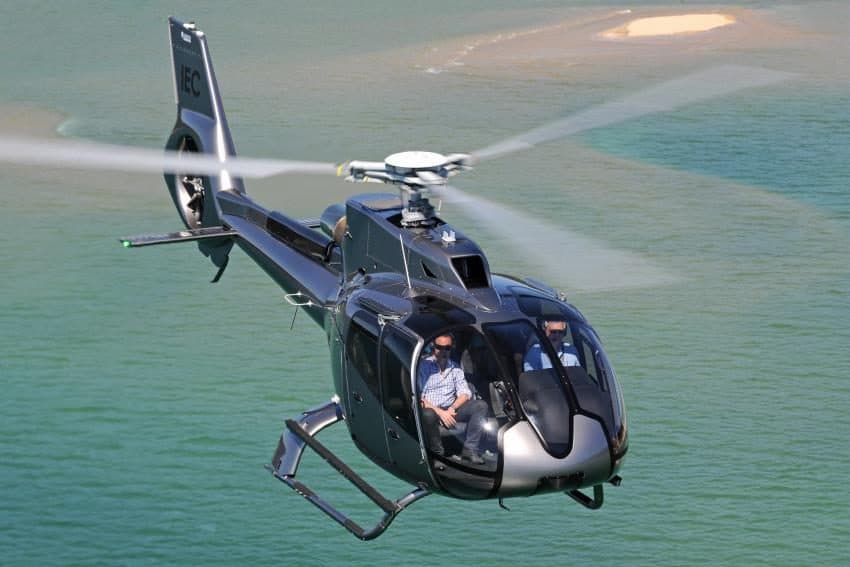
MedEvac
For smaller helicopters that are utilized for MedEvac operations, the patient’s legs and feet need to be slid down next to the pilot for transport. This places a potential threat close to the collective and fuel control levers that are mounted in between the pilot and patient.
To help increase safety all patients’ legs and feet are secured, but if the patient does manage to get free during a seizure for instance, it could present a problem. Guards are usually placed around the collective to help prevent any inadvertent and accidental interference.
The other way is to place the pilot in the left seat, just like the tour machine keeping the controls out of harm’s way.
Vertical Reference
When conducting external loads, vertical reference work, or firefighting using a long line under the helicopter the pilot needs to look straight down to see the load and the area below. When sitting in the right seat the pilot has to lean out to the right and stretch their left hand to meet the collective. Sometimes the visibility is not the best, especially for short pilots like myself!
By far the most comfortable helicopter to do external load operations with are those that are flown from the left seat. This puts the collective right under the pilot’s left arm as they lean over it to look outside. This video gives you a good view:
To Finish
Most helicopters are flown from the right seat when there is just one pilot on board. Mainly due to the traditions set forth by the first generation of pilots, but sometimes because the design of the helicopter dictates so. Having the left hand free to operate cockpit equipment is always welcomed by the majority of right-handed pilots. Having the pilot sit on the left and having to reach across the instrument panel with their left-hand makes some items unreachable in big cockpits. This is the main reason why helicopters today are flown from the right seat.
Further Reading
If you found this article interesting and helpful, may I also suggest:

